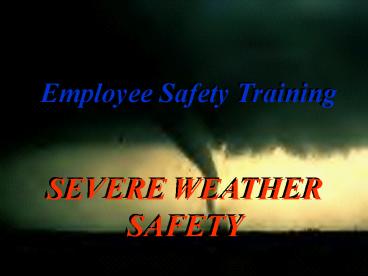SEVERE WEATHER SAFETY - PowerPoint PPT Presentation
1 / 20
Title:
SEVERE WEATHER SAFETY
Description:
Title: No Slide Title Author: WILLIAM P. NEAL Last modified by: krandolp Created Date: 5/22/2000 8:19:10 PM Document presentation format: On-screen Show – PowerPoint PPT presentation
Number of Views:281
Avg rating:3.0/5.0
Title: SEVERE WEATHER SAFETY
1
Employee Safety Training
SEVERE WEATHER SAFETY
2
FREQUENCIES
- The U.S. experiences an average of 1000 Tornadoes
each year. - Most are confined to Tornado Alley
3
Tornado Strength
F-0 40-72 mph, chimney damage, tree
branches brokenF-1 73-112 mph, mobile
homes pushed off foundation or overturnedF-2
113-157 mph, considerable damage, mobile
homes demolished, trees uprootedF-3
158-205 mph, roofs and walls torn down, trains
overturned, cars thrownF-4
207-260 mph, well-constructed walls leveledF-5
261-318 mph, homes lifted off foundation
and carried considerable distances, autos
thrown as far as 100 meters
4
TORNADO MYTHS
- Opening windows to equalize pressure
- Tornadoes never strike city areas
- The Southwest corner of a building or basement is
the safest.
St. Louis is just one of many cities to be hit.
Its just that cities make up only a very small
of land mass
5
TORNADO WATCHES / WARNINGS
- Tornado WATCH
- Simply means that conditions are right for severe
weather however, there is no current severe
weather present. - Tornado WARNING
- A Tornado has been spotted or is indicated on
radar. IMMEDIATE ACTION is needed to protect
yourself. DO NOT LOOK OUT THE WINDOW to see it.
6
TORNADO WATCHES / WARNINGS
- Warning times
- Although designed to give the greatest amount of
time before severe weather strikes, there is no
set time and/or guarantee that you have a set
amount of time.
7
Tornadoes Hazards Preparation Priorities
8
HAZARDS
- The obvious
- High winds
- Up to and including total building destruction
- Lightning
- Flying objects
- Hail and heavy rains
9
HAZARDS
- The Not-So Obvious
- Downed, energized electrical lines in and out
of buildings - Assume all lines are energized
- Electric lines can energize other objects such as
fences, steel beams etc. - Leaking gas or chemical lines
- Sharp objects
- Long span buildings are very prone to collapse.
10
PREPARATION
- Develop written Emergency Plan in advance
- Shelter locations
- Emergency alerting
- Accountability
- Weather watching
- Weather radios etc.
11
PREPARATION
- Develop a Business Recovery Plan
- Needed Sections
- Incident Management
Response - Shutdown
Inspections - Recovery
Restoration - Critical data / programs backup
- Supplier shortage effects / stopping supplies
- Post incident contacts
- Insurance, customers, suppliers, employees
12
PREPARATION
- Emergency supplies / equipment
- Portable lighting
- Roll plastic / tarps
- Personal Protective Equipment
- Medical supplies
13
PREPARATION
- Shelter selection / preparation
- Must be well marked
- Structurally sound
- Free of windows
- Easy Access
In high rise buildings, go to an interior small
room or hallway with not exterior walls and or
glassy areas.
14
PREPARATION
- Employee Training
- Where to go
- How will they be alerted
- What to do after the event
- Post event hazards to be aware of
15
PRIORITIES
- Personnel accountability
- Must account for all employees, contractors and
visitors - If lacking a plan of action, assigned shelters
etc. this will become virtually impossible - Assisting injured persons
- Remember that EMS services could easily be
overwhelmed making your problem less of a
priority to them
16
PRIORITIES
- Facility safety / hazard inspection
- Inspect for and isolate hazards to allow recovery
work to begin - Facility security
- Guard against unauthorized entry / material
removal - Student/Staff Notification
17
LIGHTNING HAZARDS
18
LIGHTNING
- Lightning causes approximately 100 deaths per
year in the United States. - Most could have been avoided had persons followed
some simple safety rules. - Remember that lighting can travel many miles from
its point of origin. - It does not have to be raining and/or completely
cloudy to be struck.
19
LIGHTNING
- Remember, If you can hear the thunderbolt, you
are close enough to be struck by the lighting - Find shelter in a car or building
- Avoid using the telephone or electrical
appliances - Stay away from windows if possible or pull down
shades or blinds - Stay away from trees or tall objects, Make
yourself Small
20
LIGHTNING
- If someone is struck by lightning
- They do not become Electrified and you can
touch them - Immediately call 911 for help
- Begin CPR if necessary
- Remember that they may also be badly burned
and/or have bone fractures - About 1/2 of persons struck will be killed































